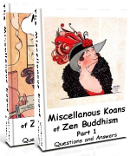Buddhism History - Ancient Times to Now
Zen Riddle #33-death :
Where do you go after death?
Here's the answer....(Show/Hide)
Want more riddles? Choose one!
#34-skirt #36-change #1-bell mumonkan
Buddhism history is, like all history, just a story.
This one tells about Siddharta Gotama an Indian ascet and muni (healer, sage), who lived around 6th century BCE.
This ethnic shakya Gotama was soon called Shakyamuni. Later many ascets regarded him as the ninth avatar (descendent) of the god vishnu, a Buddha, an enlightened being.
Many more people believed in Siddharta Gotama as an reincarnated, enlightened Buddha. Until today this belief, Buddhism, spread all over Asia.
This Buddhas teachings differ in many ways from traditional Advaita (Hinduism) believes. Just three example: there are no casts in Buddhism and no gods. And instead of Karma, Buddhists belief "Buddhanature" is already ingraned in all creatures that live.
That's the whole story of Buddhism, isn't it? Let's see.
The Beginning in India
Buddhism starts with stories about Siddharta Gotama, a farmer who became an ascet and Buddha.
He lived most probably in 6th century BCE in norther-eastern India. He was not an Indo-Aryan but an ethnic Shakya.
 History of Buddha
History of Buddha
- Who were the tribes that lived in India long before Gotama was born?
Where did they come from? - Who were the Indo-Aryan tribesmen, who invaded most of northern India only 700 years before Gotama lived in the region?
- This is very true for the early history of ancient India from about 60,000 years onwards.
- The story about the last 4000 years of ancient India history includes challenging findings about the Indo-Aryan roots of today's Indian elite and middle classes.
- To make the oldest stories more reliable, references, sources and some discussions about the ancient history of India are gathered in a brief overview of all the Indian stories.
- The history of Buddha doesn't suffer from a lack of sources but from too many contradictory legends, that each express the truth about their respective Buddhist faction.
 Buddhist belief
Buddhist belief
Religion for the World
Historical storytelling is always risky for it needs the teller to sort out information and to limit his imagination.
Fortunately the outcome doesn't need to be consistent, it just needs to be a good story.
That's especially true for the brief history of Buddhism.
It's all about the transformation of an obscure 5th century BCE story from the foothills of the Himalayas into the blueprint of a world religion.
At the beginning of the Common Era (CE) Buddhism had become the dominant intellectual and cultural focus of philosophy and religion in Asia.
Countless Buddhist missionaries and merchants went abroad and Buddhist scholars from everywhere came to India to study.
But slowly the center of Buddhist culture shifted from North India to South Asia and China.
Dialogue of Civilisations
Taoists and Buddhist monks in Nothern China transcribed and translated thousands of Buddhist scriptures.
They often translated the Sanskrit text with Taoist terms and patterns. "Chan" (channa) translated the sanscrit term "dhyanna".
Many of the ancient documents of Buddhism survived only in their Chinese transcription as "Chan teachings".
But government suppression in the 9th century nearly ended Buddhism China history .
But Chan was revived in the 10th century (Buddhism China) and only focused on meditation.

Zen saying
Later Zen Buddhism was practised by Japan's ruling class, but was soon forgotten.
In the early 18th century it was rediscovered in Japan, defined as "national heritage" and survived as a sterile monastic cult until today.
From the mid-20th century Japanese masters introduced Zen in Western countries.
Organized Zen today all over the world is an imitation of Japanese culture, rituals and behaviour, the most rigid form of spirituality in Buddhism history.
Return to Home Page from Buddhism history



